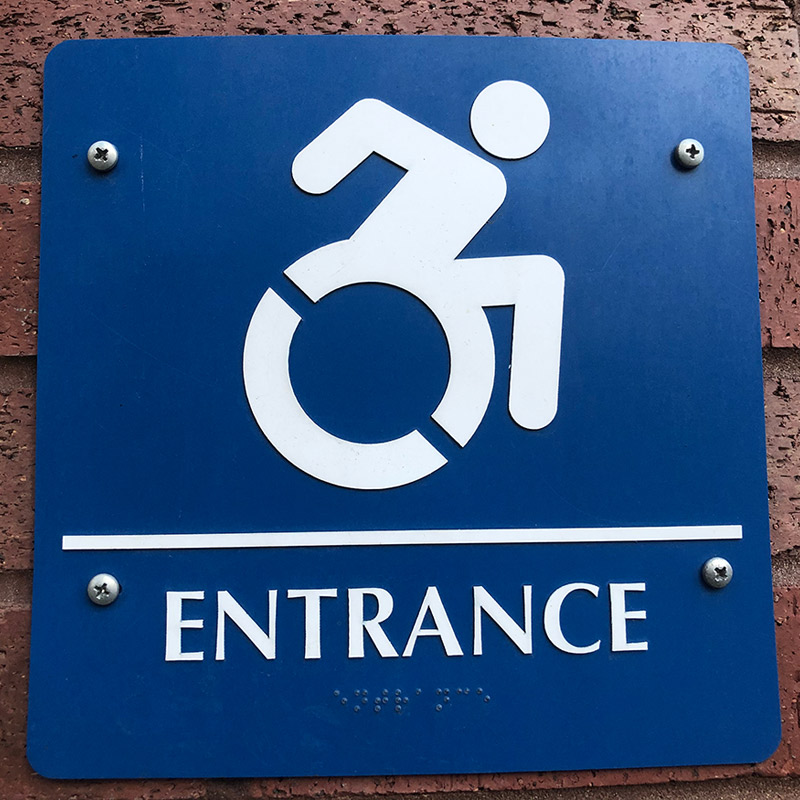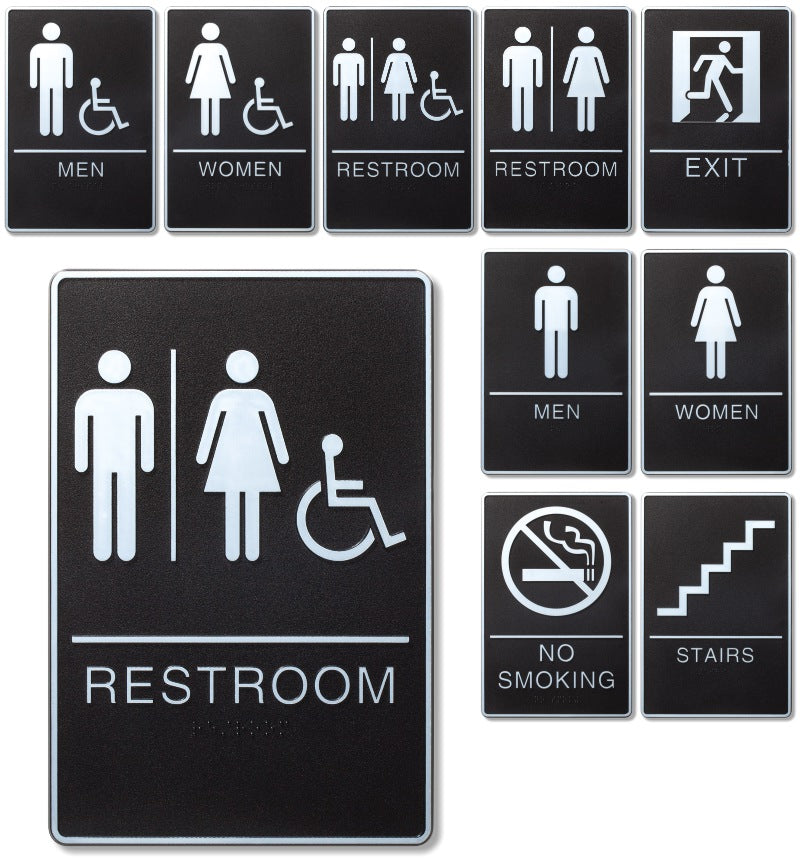Checking Out the Secret Functions of ADA Signs for Boosted Access
In the world of accessibility, ADA indicators serve as quiet yet effective allies, guaranteeing that areas are comprehensive and navigable for people with handicaps. By incorporating Braille and responsive elements, these indications damage barriers for the aesthetically damaged, while high-contrast color schemes and understandable font styles provide to varied visual requirements.
Significance of ADA Conformity
Making certain compliance with the Americans with Disabilities Act (ADA) is vital for fostering inclusivity and equivalent access in public spaces and work environments. The ADA, established in 1990, mandates that all public centers, companies, and transport services accommodate people with specials needs, ensuring they delight in the exact same civil liberties and possibilities as others. Compliance with ADA criteria not only meets lawful commitments but likewise improves a company's online reputation by demonstrating its commitment to variety and inclusivity.
One of the key aspects of ADA conformity is the application of easily accessible signage. ADA indications are created to guarantee that individuals with handicaps can quickly browse through structures and rooms.
Moreover, sticking to ADA regulations can mitigate the threat of lawful consequences and prospective fines. Organizations that stop working to adhere to ADA standards might face legal actions or charges, which can be both destructive and economically burdensome to their public image. Therefore, ADA compliance is important to fostering an equitable environment for everybody.
Braille and Tactile Elements
The unification of Braille and tactile aspects right into ADA signage personifies the principles of availability and inclusivity. These attributes are vital for individuals who are blind or aesthetically impaired, enabling them to browse public rooms with better independence and self-confidence. Braille, a tactile writing system, is essential in supplying written info in a layout that can be easily viewed via touch. It is normally placed below the equivalent message on signs to guarantee that people can access the details without visual support.
Tactile elements expand beyond Braille and include elevated characters and signs. These parts are developed to be discernible by touch, allowing people to recognize area numbers, restrooms, exits, and other critical locations. The ADA establishes certain guidelines pertaining to the size, spacing, and positioning of these tactile components to maximize readability and ensure uniformity throughout various atmospheres.

High-Contrast Color Design
High-contrast color systems play an essential role in enhancing the presence and readability of ADA signage for people with visual problems. These plans are vital as they take full advantage of the distinction in light reflectance between message and history, making certain that indications are quickly discernible, also from a range. The Americans with Disabilities Act (ADA) mandates making use of details color contrasts to suit those with limited vision, making it a crucial aspect of conformity.
The efficacy of high-contrast shades exists in their capability to attract attention in various illumination problems, including poorly lit settings and areas with glow. Normally, dark message on a light background or light text on a dark history is employed to accomplish optimum contrast. Black text on a white or yellow background provides a plain aesthetic distinction that assists in quick recognition and comprehension.

Legible Fonts and Text Size
When taking into consideration the style of ADA signage, the choice of understandable typefaces and proper message size can not be overemphasized. The Americans with Disabilities Act (ADA) mandates that typefaces need to be sans-serif and not italic, oblique, script, highly attractive, or of uncommon type.
According to ADA standards, the minimum message height should be 5/8 inch, and it needs to enhance proportionally with viewing range. Consistency in message size adds to a cohesive aesthetic experience, aiding people in navigating settings effectively.
Furthermore, spacing between lines and letters is important to clarity. Ample spacing avoids personalities from showing up crowded, improving readability. By sticking to these requirements, developers can considerably boost ease of access, making certain that signs serves its intended function for all people, no try this matter their visual abilities.
Reliable Placement Methods
Strategic positioning of ADA signage is necessary for taking full advantage of ease of access and ensuring compliance with lawful criteria. Properly positioned indications assist individuals with handicaps effectively, promoting navigation in public spaces. Secret factors to consider consist of elevation, distance, and presence. ADA guidelines state that indications need to be placed at an elevation between 48 to 60 inches from the ground to guarantee they are within the line of view for both standing and seated individuals. This typical height variety is crucial for inclusivity, making it possible for mobility device individuals and people of varying elevations to accessibility details easily.
In addition, indications have to be placed adjacent to the lock side of doors to enable simple recognition before entrance. Consistency in indicator positioning throughout a facility enhances predictability, decreasing confusion and boosting overall user experience.

Verdict
ADA indicators play an essential duty in promoting accessibility by integrating functions that deal with the demands of people with disabilities. Including Braille and responsive elements makes certain essential information comes to the aesthetically impaired, while high-contrast color design and readable sans-serif font styles boost visibility across different lighting problems. Reliable placement techniques, such as suitable installing heights and tactical locations, additionally help with navigation. These aspects jointly promote a comprehensive setting, highlighting the significance of ADA conformity in making certain equal accessibility for all.
In the realm of access, ADA indicators serve as silent yet effective allies, making certain that areas are comprehensive and navigable for people with disabilities. The ADA, passed in 1990, mandates that all public centers, employers, and transport solutions suit individuals with disabilities, ensuring they delight in the very same rights and possibilities as others. ADA Signs. ADA indications are made to ensure that individuals with impairments can easily navigate with areas and buildings. ADA guidelines stipulate that indicators need to be installed at an elevation in between 48 to 60 inches from the ground to ensure they are within the line of view for both standing and seated people.ADA indications play this website an essential function he has a good point in promoting ease of access by incorporating functions that resolve the requirements of people with disabilities
Comments on “Discover the Significance of ADA Signs in Public Spaces”